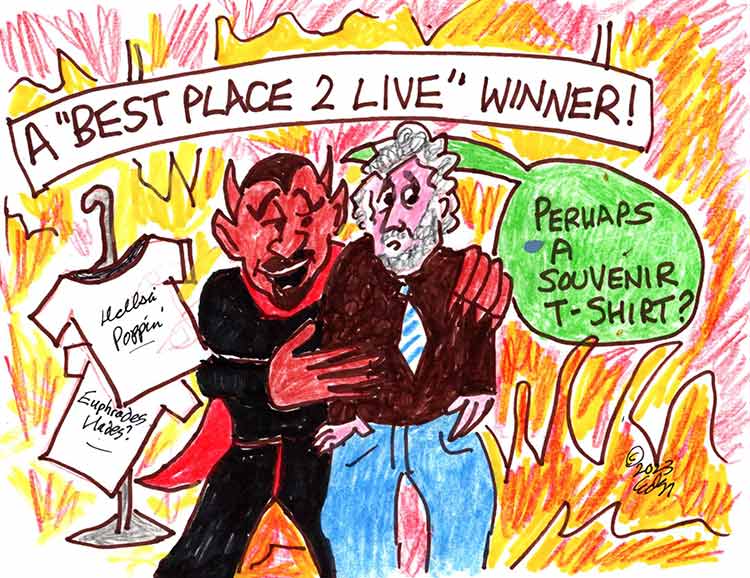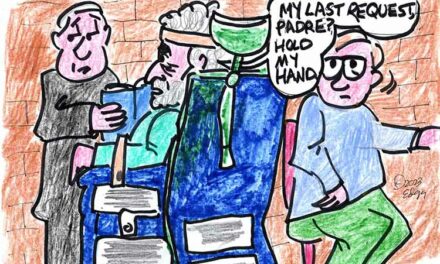Best Place to Live? In The Present
Colliding surveys can be poll-arizing
By Ed Goldman
Surveys and stories abound about the best and worst places to live.
We high-five each other when our city is named a Best Place to Live by a magazine we’re not really familiar with—though after the survey comes out, we give serious thought to subscribing to “Enviable Homes, the Journal by and for People Who Live Indoors On a Year-‘Round Basis.”
Deviled Ed
And we snark ourselves silly when our town is named a Worst Place to Live, even if the survey comes from a reputable source, such as the New York Times or the Wall Street Journal: “Oh, so what?! So they did exhaustive research, compiled and triple-checked some statistics, interviewed 32,000 residents and took photos of our 57 homeless encampments in the central city. But did they really get to the heart of what makes Pasture Pie, U.S.A. a very special place to live, work, play and die of scurvy? Did they even note that we’re the first city in the country to have above-ground radon poisoning? Did they even read our Chamber of Commerce profile?!”
Twenty-one years ago, Time Magazine published a story, based on The Civil Rights Project at Harvard University, that found Sacramento to be “America’s Most Diverse City.” Local leaders and boosters weren’t sure what to do with the information which—despite the study’s academic and journalistic pedigrees—seemed dubious at best, hilarious at worst.
For example, some economic development people, who try to lure companies to relocate here, wondered (though not aloud, of course) if the findings would be viewed as favorable. So did realtors, tourist agencies and some upscale retailers, who weren’t sure that “diverse” was a good descriptor to encourage potential visitors and settlers. They seemed to think it was a code word for “race riots re predicted” instead of a term that expressed the American ideal of being a melting pot.
A local paper at the time interviewed a bunch of people, including me, about our reactions to the story.
Since I was born in Harlem, New York, which is in upper Manhattan, and I lived in the multi-cultural borough of the Bronx until I was eight years old, I expressed some doubt about the survey’s veracity—especially since Oakland and San Francisco, each about a two-hour drive from Sacramento, and Los Angeles, a one-hour flight away, would seem to have had at least as diverse a population as California’s capital. If not waaaaay more.
In the years since the 2002 story was published, other cities have weighed in, apparently resentful they weren’t cited for their own heterogeneity. So I guess they thought the label could be useful. On the other hand, it could just have been a case of inter-city rivalry, of wanting to be at the top of whatever lay underneath. “Hey, we have far more neglected roads than your city!” “Oh yeah? Well, we could beat you on blight and brown fields in a walk, pal!”
Here’s what my residency with the Department of Earth has taught me over the past several decades. The worst place to live, hands down, isn’t in the ghetto, a shtetl, the shadow of a decommissioned but still-leaky nuclear plant or an earthquake zone.
It’s in the past. While that sometimes seems like an attractive locale, the past won’t promote your well-being or your dreams—only your memories. They’re worth cherishing or, in some cases, trying your damnedest to move on from. After all, if you’re very lucky, your next re-lo from the present will be into the future. To quote the inventor Charles Kettering: “My interest is in the future because I am going to spend the rest of my life there.” He died the year I moved out of the Bronx, by the way. But that was so 1958.
Ed Goldman's column appears almost every Monday, Wednesday and Friday. A former daily columnist for the Sacramento Business Journal, as well as monthly columnist for Sacramento Magazine and Comstock’s Business Magazine, he’s the author of five books, two plays and one musical (so far).













